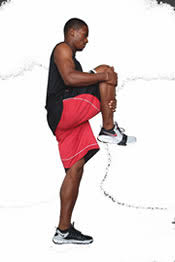 Does this mean we should just stop warming-up and stop stretching all together? Hardly. In a field of ever evolving information and discoveries, we are finding that this is an area that is getting a much-needed revamp. Warming-up needs to be something that gets your blood pumping and muscles ready to go. A five-minute light jog, a few sets of jumping jacks or sport specific activities like a few practice serves at tennis can go a long way. Prepping muscles for activity through these movements are known as active or dynamic stretches. Specifically we are talking about mimicking movements that will be used during a sport activate multiple muscle groups. Often one muscle may be stretched while the antagonist (opposite) muscles are working (think walking knee hugs: stretching hamstrings and glutes while contracting hip flexors). Moving through sport specific motions and dynamic activities better activate muscles for any activity from dancing to football.
Does this mean we should just stop warming-up and stop stretching all together? Hardly. In a field of ever evolving information and discoveries, we are finding that this is an area that is getting a much-needed revamp. Warming-up needs to be something that gets your blood pumping and muscles ready to go. A five-minute light jog, a few sets of jumping jacks or sport specific activities like a few practice serves at tennis can go a long way. Prepping muscles for activity through these movements are known as active or dynamic stretches. Specifically we are talking about mimicking movements that will be used during a sport activate multiple muscle groups. Often one muscle may be stretched while the antagonist (opposite) muscles are working (think walking knee hugs: stretching hamstrings and glutes while contracting hip flexors). Moving through sport specific motions and dynamic activities better activate muscles for any activity from dancing to football. Now, before you put an end to ALL static stretching, know that it still holds benefit. It is all dependent upon when you stretch. Once an exercise or workout bout is complete, feel free to spend time touching your toes and stretching your triceps during your cool down. This is the time research is finding great value for static stretching. It can help relax muscles and relieve tension accumulated during a work out. Stretching also increases joint flexibility and circulation, which helps speed muscle recovery.
At Prevail Conditioning Performance Center we take our clients through a thorough Self Myofascial Release, Corrective/Active-Isolated/Mobility Stretch, Activation and Movement Prep before every workout session and conclude with Static, Neuromuscular or Active Isolated Stretching Post Workout.
Prevail Conditioning will be offering a midday stretching class starting soon for any interested in learning more on how to safely and effectively use stretching to relax muscles, increase flexibility and improve circulation.

Julian Boubel, BS, CSCS is a Strength & Conditioning Coach for Prevail Conditioning Performance Center and works with athletes and fitness enthusiasts alike. For further information regarding this topic please contact Juliann Boubel, BS, CSCS at Juliann@prevailconditioning.com.
References:
1. Foster, Mary Ann. "13 Tips for Stretching Sanity." Massage & Bodywork 20.5 (2005): 58-59.
2. Cheng, Maria. "Stretching could be harmful. " McClatchy - Tribune Business News, April 18, 2010.
3. Ecklund, Chris. “When is the Best Time to Stretch…and How.” www.prevailblog.com. December 7, 2007.
4. “Experts Don’t Stretch Before Exercise.” April 15, 2010. www.usatoday.com/news/health/2010-04-15-stretching-muscles_N.htm

No comments:
Post a Comment